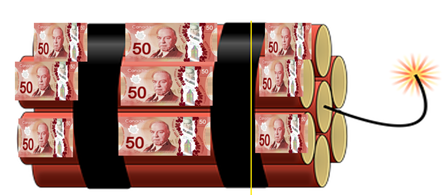
By Michael O’Neill
“TNT, I’m a power load, TNT, watch me explode.” AC/DC has been collecting royalties on that song for forty-four years, and they haven’t exploded, yet. The Canadian dollar might not enjoy the same longevity in the post-pandemic world. The ever-increasing mountain of government debt is an unstable nitroglycerin barrel, rapidly, rolling towards an unsuspecting marketplace. If it blows, it will take out investors, and the Loonie. But will it?
To say that the federal budget has taken a hit because of the coronavirus pandemic is an understatement. It wasn’t just hit; it was battered, smacked, then stomped, until it ballooned to a deficit approaching World War ll levels. Then it got worse. In August, the government was forced to ease qualifying rules for unemployment benefits as existing benefits ran out. A resurgence of COVID-19 in major urban centers exacerbated the situation. The Parliamentary Budget Office said that change will cost $13.5 billion, on top of the existing $328.5 billion deficit.
The expenditures were necessary. The alternative was a repeat of massive Depression-era unemployment, homelessness, and hunger when businesses went bankrupt, employees were furloughed, and farms collapsed. Back then, the government largely ignored the problem and according to the Canadian Encyclopedia, the feds “reluctance to tackle unemployment contributed to a fiscal collapse in the four western provinces and in hundreds of municipalities.”
That’s not the case in 2020.
The federal government rose to the occasion. The doled out funds for the Canada Emergency Business Account, Canada Emergency Wage Subsidy, Canada Emergency Response Benefit, and even gave money to students. There is more. There is a “caregiver” subsidy and a mortgage deferral scheme. Seniors who were 65 or older in June received one-time payments. Business found themselves with a smorgasbord of financial support, from interest-free loans, loan guarantees. There is even sector-specific support. Few, if any groups did not see a targeted support program.
It worked. The Canadian economy grew 3% in July, after growing 6.5% in June, and the Canadian dollar recovered all of its initial pandemic losses. The question is “how will the Canadian dollar perform in the coming months?”
The answer: “its complicated.”
USDCAD price action has largely decoupled from oil price movements, and the impact of top-tier domestic economic data is fleeting. It isn’t alone. For the most part, the major G-10 currencies rise or fall, depending upon the prevailing US dollar sentiment of the day. That’s because their economies are paddling the same canoe in the COVID-19 river.
World leaders acted in unison to support their economies, and prudent fiscal management was collateral damage. Central bankers did their part, slashing interest rates and expanding quantitative easing programs. It’s working.
Their economies are on an uphill trail to recovering to pre-pandemic levels. But like any trail, there are twists, turns and pitfalls. Not all recoveries will be equal.
Take Australia and Canada for example. FX traders tend to slot Australia, New Zealand, and Canada into the “commodity currency” category. The Canadian and Australian economies are similar. They are resourced based and rely on a single major, often belligerent, trading partner. Canada’s total GDP of around USD1.71 trillion exceeds Australia’s USD1.43 trillion, but AUDUSD is the more popular currency in FX trading. AUDUSD accounts for 7% of the daily market turnover compared to 5% for USDCAD.
Australia has a much smaller budget deficit which means there is more room for officials to inject additional stimulus. By itself, it suggests the Australian dollar would outperform the Loonie. But only if deficits matter and in the current scheme of things, deficits do not matter.
However, central bank policies have diverged somewhat. The Reserve Bank of Australia (RBA) is on the cusp of cutting interest rates into negative territory, expanding their quantitative easing program, and tacitly endorsing a weaker currency. That is not the Bank of Canada’s playbook. The BoC acknowledged that negative rates were in their “toolbox,” but were concerned about the side effects in later years.
The “uber-dovish RBA compared to the “cautiously” dovish BoC suggests the Canadian dollar will outperform the Australian dollar, against the greenback.
But what happens when interest rates rise? AUDUSD will outperform USDCAD as Australia’s smaller budget deficit and a vibrant resource sector, will shine compared to Canada’s massive deficit and decimated oil industry.
Rising inflation used to be the catalyst for a rate increase. That may not be the case in the future. Massive government deficits in the G-7 mean it is in their best interest to keep rates at extremely low levels. That may be why Central Bankers are tweaking inflation calculations and talking about tolerating higher levels.
Arguably, Canada’s ballooning government deficit is just a problem for academics and economists, and not for traders. If the Loonie blows up, it won’t be from government deficits, at least, not this year.





